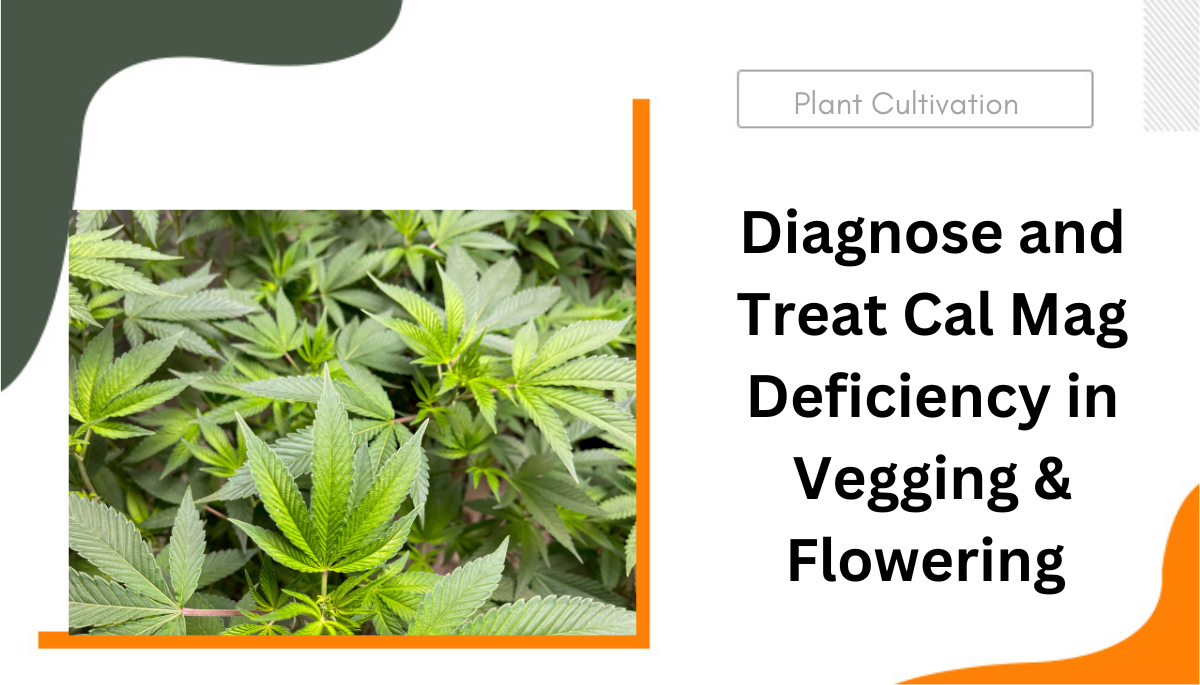Cal Mag Deficiency Weed: Causes, Symptoms, and Efficient Treatments
Calcium and magnesium are two essential nutrients that plants need to grow and thrive. However, many of you may face challenges with Cal Mag deficiency during cannabis growth stages, particularly in the vegging and flowering phases. When your plants don't get enough of these nutrients, they can develop a wide range of symptoms that can be difficult to diagnose. Luckily for you, by learning how to spot the signs of Cal-Mag deficiency and taking proactive approaches to nutrient treatment, you can fix Cal Mag deficiency with ease.
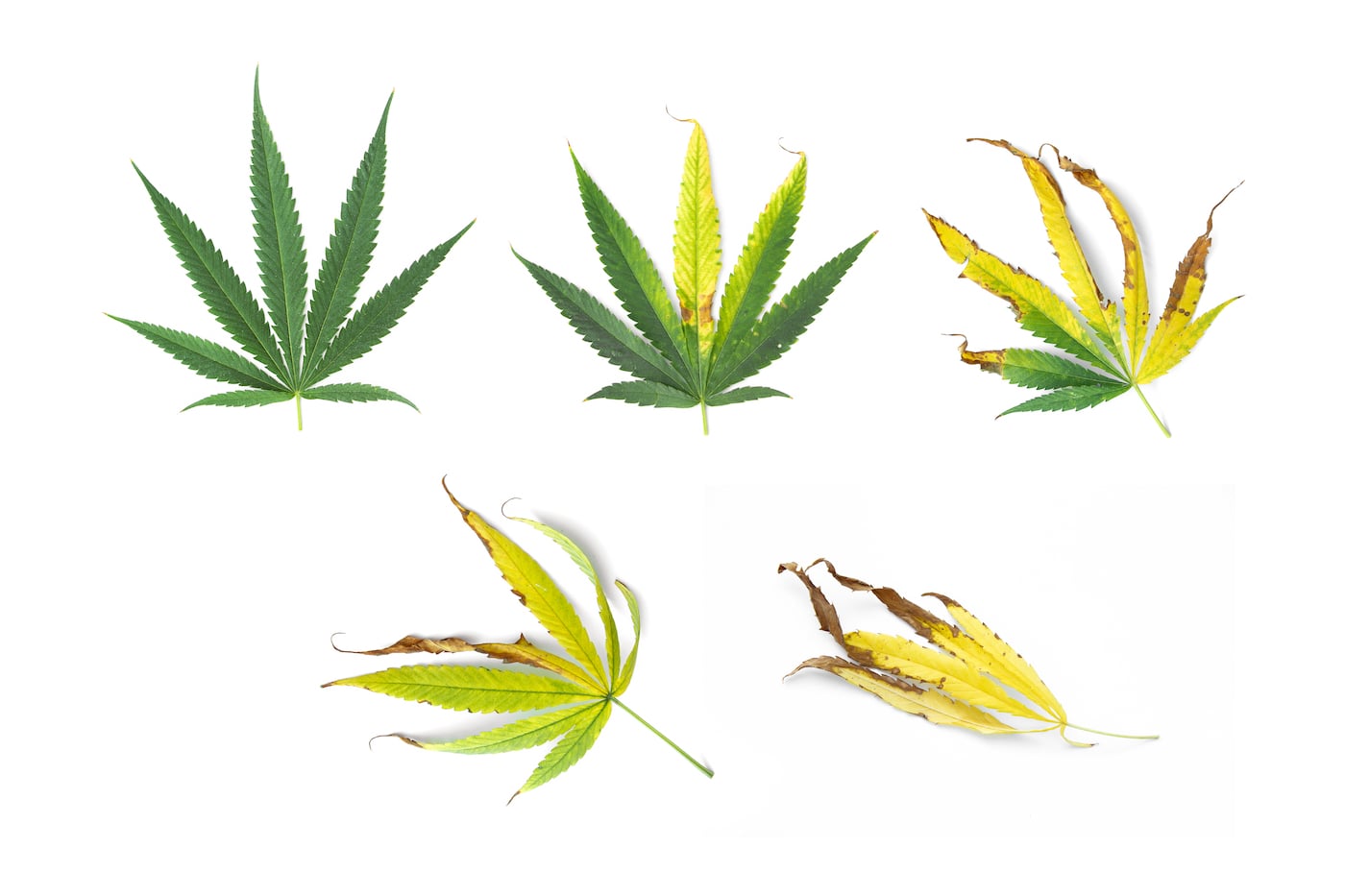
Table of Contents
What Are the Reasons Behind Cal Mag Deficiency
To start with, knowing why is there Cal Mag deficiency helps to spot the reason in your own case and react accordingly. While Cal Mag deficiency weed is mainly subject to three conditions, soil, water, and fertilizers, there are plenty of minor factors that can result in this issue. Let’s break it all into pieces.
High Soil Acidity and Alkali
The pH level plays a vital role in how your plants take in Cal and Mag from the soil. Acidic soil (pH below 6.0) can limit plant uptake of calcium and magnesium, while highly alkaline soil (pH above 8.5) can cause these nutrients to become insoluble due to reactions with phosphate ions, thus hindering their availability for plant absorbing Cal and Mag. 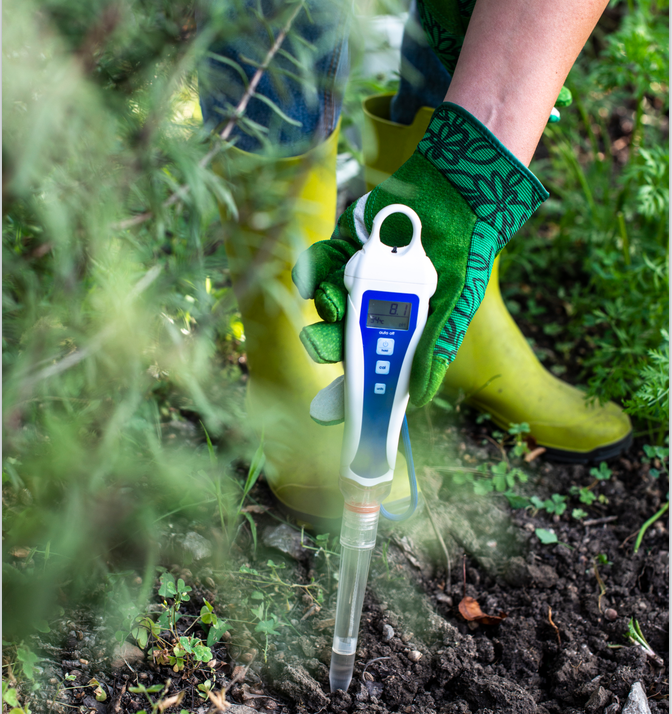
Low Transpiration Rates
Factors such as high humidity, cold weather, and insufficient cannabis watering can contribute to low transpiration rates, the extent to which water is released from plant leaves into the air. A low transpiration rate in plants prevents nutrients from being transported from roots to other plant parts, leading to Cal, Mag, and also other nutrient deficiencies.
Use of RO-Treated Water
The use of treated water such as distilled or reverse osmosis water is one of the leading contributors to Cal Mag deficiency. Unlike rainwater and tap water, which contain essential minerals such as calcium and magnesium for optimal plant growth, treated water is often stripped of these nutrients as they get purified.
Excessive Use of Fertilizers
Overuse of potassium (K) and ammonium-based fertilizers changes the soil chemistry and causes a reduction of soil microorganisms that are responsible for breaking down organic matter. Therefore, the less organic matter content, the fewer nutrients including Cal and Mag.
Use of Soft Water
If you grow your cannabis with soft water, typically defined to have a low concentration of dissolved minerals, specifically calcium and magnesium, it explains why your weed is lack of Cal and Mag.
Soil Texture
Soils with low organic matter content have lower calcium and magnesium levels, as these nutrients are released slowly from organic matter as it decomposes. For example, if you are using sandy or coarse soil or coco coir, these types of soil will be likely to trigger Cal Mag deficiency in contrast to loamy and clayey soils.
Environmental Stress
Extreme temperatures, drought, or other environmental stresses can interfere with nutrient uptake and contribute to calcium and magnesium deficiencies in plants. For example, in the case of cannabis plants, drought can cause the soil to dry up, which limits the plant's ability to absorb water and nutrients, including calcium and magnesium.
With all these causes being said, how do you identify if your plants are suffering from Cal Mag deficiency? Read on to know what are the signs of Cal Mag deficiency in your cannabis.
Symptoms of Cal-Mag Deficiency Weed
The symptoms can vary depending on specific plant species and different causes, but there are some common symptoms in each plant growth stage.
Symptoms of Cal-Mag Deficiency in Seedling
A well-balanced nutrition marks a good start for how your plants grow. However, lacking Cal and Mag at the seedling stage will send plants off on a negative trajectory from the very beginning. The signs of Cal Mag deficiency during the seedling stage include:
- An abnormal slowdown of plant growth. For instance, the plant may appear smaller than expected and may not develop an expected number of branches.
- The leaves change color from green to yellow and brown.
- Much weaker and incompetent stems compared to healthy plants. What’s worse, you might see purple stem weed.
- Cannabis leaves curl up or downward.
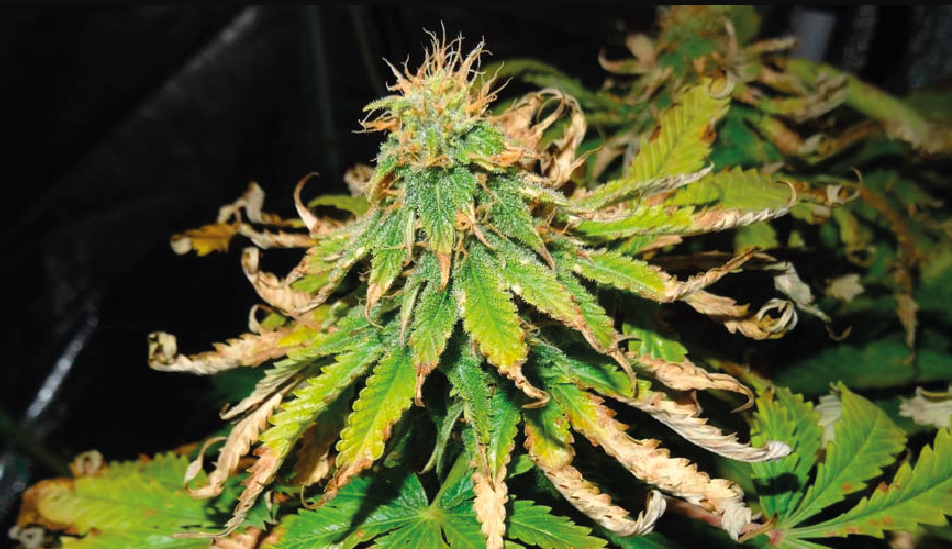
Cal Mag Deficiency in Veg
During the vegetative phase, your cannabis focuses its energy on photosynthesis and growth. However, insufficient levels of calcium and magnesium can hinder this process and result in unsatisfactory outcomes later on. Symptoms of Cal-Mag lack in the vegetative stage include:
- Brown or yellow spots on cannabis leaves. The spots may start off as small but can grow larger if the deficiency is not corrected and eventually lead to the death of affected leaves.
- A slower rate of growth because the plant is unable to photosynthesize efficiently.
- Crispy and brittle leaf tips. As the deficiency progresses, the edges of the leaves will start to dry out and turn brown. The affected ones will eventually become brittle and fall off.
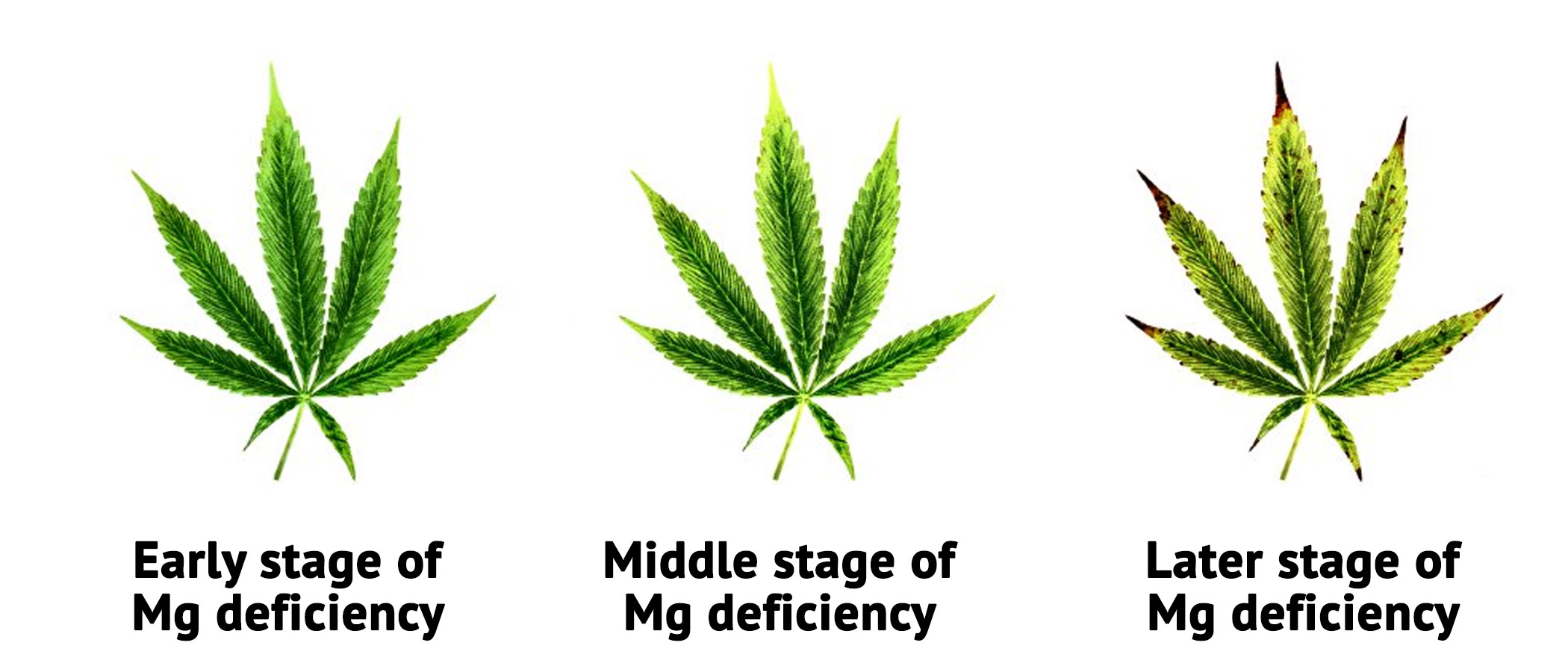
Flowering Cal Mag Deficiency
Essential for transpiration, photosynthesis, and nutrient uptake, the flowering stage’s Cal and Mag insufficiency can show the following visual indicators.
- Large, light, and rusty-colored spots may appear, be they yellow, brown, or even purple. The edges of cannabis leaves may also turn crispy or brittle.
- Loose and small buds. Plants lack enough Cal and Mag tend to produce fewer buds as well.
- Low yields. Unfortunately, you won’t experience robust harvests from plants with Cal Mag deficiency.
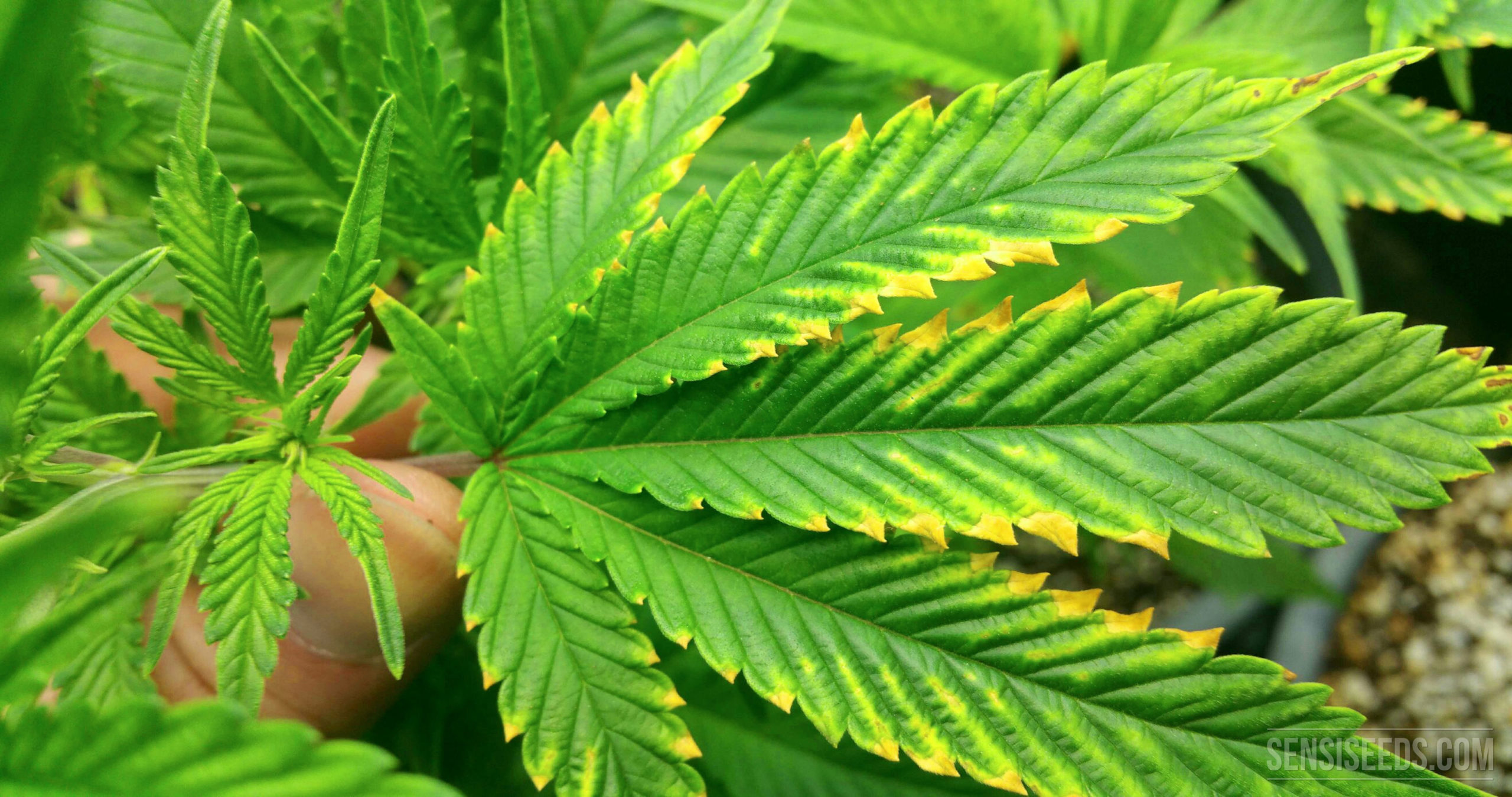
How to Treat & Prevent Cal Mag Deficiency [Working Solutions]
If you think your plants are experiencing Cal-Mag deficiency after checking out all manifestations above, this part will save you from the plight by focusing on solutions to fix and prevent Cal-Mag deficiency weed.
Test & Adjust Soil pH
The ideal pH level for most plants, including cannabis, is between 6.0 and 7.0, which is slightly acidic to neutral. You can use a DIY kit to test the pH level before making any alternations.
If the pH level is too high (alkaline), you can add organic matter, such as compost or peat moss, to the soil to lower the pH. However, if the pH level is too low (acidic), you can add lime or wood ash to raise the pH level.
Use Cal-Mag Supplements
Obviously, you can adjust Cal-Mag deficiency by adding exclusive Cal-Mag supplements. Come in different forms, including powders, liquids, and granules, these supplements contain balanced amounts of calcium and magnesium that would be a good fit for your plants, no matter whether you are growing in hydroponics vs soil growing.
However, it’s worth noting that please follow the manufacturer's instructions for use, just in case of any nutrient burn or imbalance.
Adjust the Nutrient Solution
As addressed above, overuse of fertilizers results in insoluble calcium in the soil. Therefore, it’s suggested to stop using strong phosphorus-based fertilizers and flush the plants with pH-neutral water. Then you can apply a well-balanced formula that won’t harm the absorption of soil microorganisms.
Improve Irrigation
You can tell that proper watering is crucial to ensure the plant takes up enough nutrients. To expand further on this, you can consider the two aspects:
- Use hard water rather than soft water. Hard water contains abundant calcium and magnesium, while soft water is deprived of Cal and Mag through water softener systems.
- Use tap water and rainwater instead of distilled or RO-treated water. However, it’s better to purify tap and rainwater before putting them into use.
Pay Attention to the Climate
For indoor gardeners, the temperature and humidity for cannabis seedlings have a great influence on how nutrient is absorbed by the plant. High temperatures and low humidity levels can lead to an increase in transpiration rates, which will later cause the plant to lose water and nutrients more rapidly. You may refer to the grow room temp and humidity chart below for an ideal temp and humidity level for your weed growth.

humidity and temperature for different stage
In addition to these fixes to curing the Cal-Mag deficiency, you should keep an eye on the plants and monitor their condition regularly to further prevent nutrient deficiency. If the deficiency persists, consult a professional for more professional advice.
Verdict on Cal-Mag Deficiency Weed
To sum up, calcium and magnesium deficiency is a common problem that can affect the growth and yield of cannabis. Understanding the symptoms of cal-mag deficiency during different growth stages and identifying the causes helps to prevent and treat the issue. Then deploying solutions that are listed in the post will certainly work to improve nutrient insufficiency. If you have any suggestions or questions, don’t hesitate to leave a comment below.
FAQs about Cal Mag Deficiency
- How do I know if I have Cal Mag deficiency?
Several signs can show up if your plants are experiencing calcium and magnesium deficiency. However, the very first symptom is usually small spots showing up in the middle of older leaves in the color of brown and yellow.
- Will Cal Mag fix magnesium deficiency?
Yes, Cal Mag supplement or fertilizer can fix magnesium deficiency as it contains both macronutrients in a balanced ratio. Calcium helps in the absorption and transportation of magnesium to different parts of the plant. However, it is advised to identify the root cause of magnesium deficiency before proceeding with any supplements.
- Is Cal Mag good for nitrogen deficiency?
Unfortunately, Cal-Mag supplement is not effective for treating nitrogen deficiency since it only provides calcium and magnesium, which are secondary macronutrients that plants need in smaller amounts. You can address Nitrogen deficiency by providing the plant with a nitrogen-rich fertilizer or organic material such as compost or manure.


